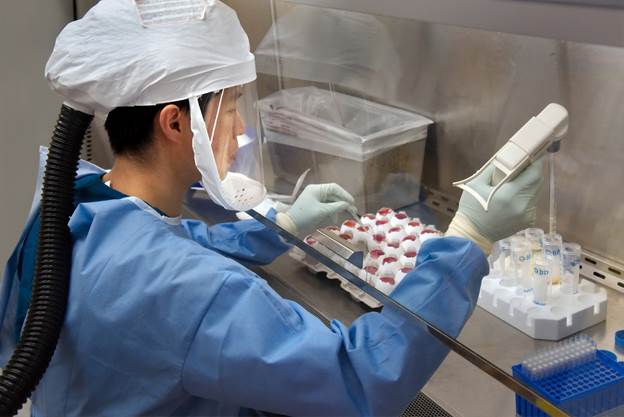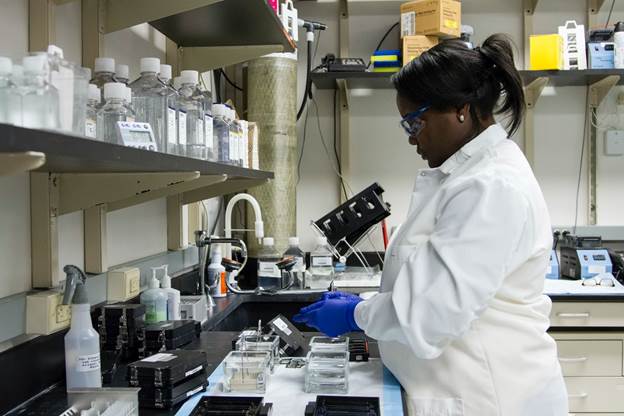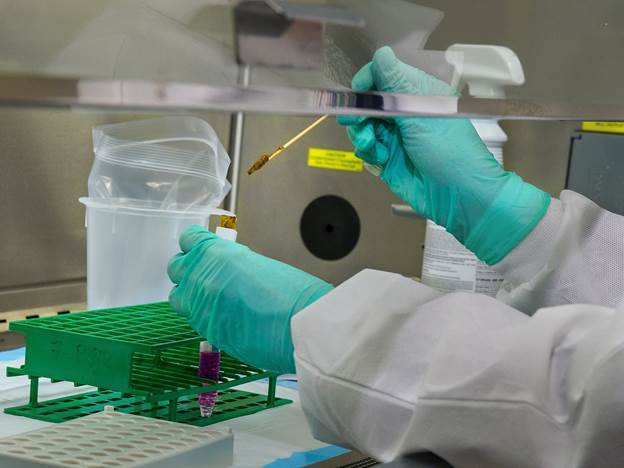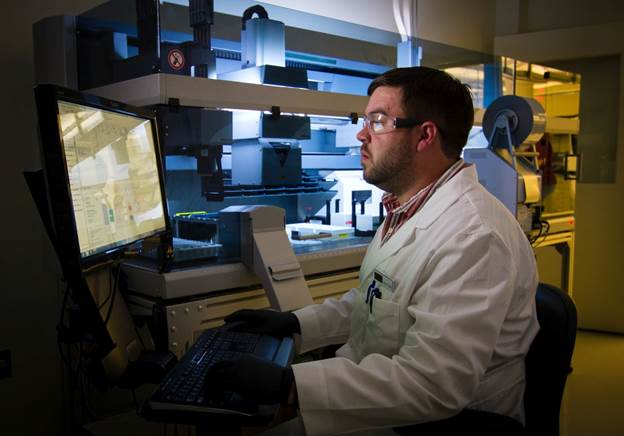What is the Role of Peptide Synthesis?
Jan 16th 2023
In modern medicine, researchers use peptide applications to diagnose and treat cancer, map epitopes, make antibiotic drugs, design vaccines, and offer custom antibody sequencing services. Moreover, the processes necessary to create vaccines have also aided the progress of synthetic peptides.
Since peptide synthesis was discovered, it has been used in many different ways. For example, synthetic peptides are now used to make specific epitope antibodies against pathogenic proteins, to study how proteins work, and to identify and characterize proteins.
Synthetic peptides make it possible to study essential enzymes for cell signaling, like proteases and kinases, and especially to figure out how enzymes interact with their substrates.
What is Peptide Synthesis?

Peptide synthesis occurs when a peptide bond is formed between two amino acids. Although there is no definitive depiction of a peptide, it usually refers to chains of 30–50 amino acids that are flexible and have little secondary structure.
Linking amino acids together with peptide bonds has been possible for more than 100 years, but the first peptides, like oxytocin and insulin, were not made for another 50–60 years. This shows how hard it is to chemically make chains of amino acids. In the last 50 years, chemistry and methods for making proteins have improved to the point where peptide synthesis is now a common way to do biological research, product and drug development, and even high-throughput scientific analysis.
The good thing about peptide synthesis strategies today is that they can make peptides found in biological samples. Still, they can also use creativity and imagination to create new peptides to get the natural response or other desired results. This page talks about the most crucial parts of peptide synthesis, the most common ways to make and clean peptides, and the pros and cons of each method.
Solid Phase Peptide Synthesis

During solid-phase peptide synthesis, the polypeptide chain must be attached to a solid polymer as a connector and catalysis surface. The polymer is only active toward the first amino acid in the sequence and unresponsive to subsequent amino acids. Treatment with a weak acid cleaves the bond between the polymer and the first amino acid. As a result, the peptide chain only has a temporary bond with the solid polymer.
The free amino acids or the expanding chain attached to the polymer can't interact with one another. This is because amino acids like Fmoc and Boc have protective groups atop their reactive sites. These shields reduce the likelihood of spontaneous reactions, disrupting the synthesis of a prescribed sequence of amino acids. Researchers can selectively activate individual amino acids in a mixture by using different chemical processes to remove the protecting groups.
Once the peptide chain is fully formed, it must be released from the polymer through digestion. However, the system must be washed to eliminate unwanted soluble compounds before digestion can begin. Once the polypeptide chain has been isolated from the polymer resin, the resulting solution is much more concentrated.
Peptide Synthesis Method
The carboxyl portion of an incoming amino acid is usually coupled to the N-terminus of the expanding peptide chain during peptide synthesis. Contrast this C-to-N synthesis with protein biosynthesis, in which an amino acid is incorporated into a protein chain from its N-terminus (N-to-C).
The precise, step-by-step, and cyclic addition of amino acids to the burgeoning peptide chain is necessary for the complexity of in vitro protein synthesis. Although the most popular approaches to peptide synthesis differ in several respects, they all involve the sequential addition of amino acids to an already-existing peptide chain.
The Role of Peptide Synthesis
The advantages of peptide synthesis include the following:
1. The Convenience of Diluting Out Unwanted Liquid Compounds
The initial amino acids in the peptide chain are bonded to a polymer substrate to create a polypeptide using the solid phase method. All molecules bound to the polymer are insoluble, allowing easy separation from the washable, free-floating molecules. Anchoring a peptide chain to a polymer facilitates the desired chemical reactions in free-floating amino acids and the existing chain. The stability of the chain lessens fluctuations in the water system.
2. Decreased Efforts to Conduct Experiments
Sometimes, the potential benefit outweighs the tremendous cost of fixing human mistakes. In addition to error correction's financial and time costs, such projects rarely see the light of day. Additionally, by automating the SPPS process, labs can reduce their error propensity and free up funds previously allocated for such repairs.
3. Speeds Up the Rate of Discoveries

Using automated workstations for custom peptide synthesis has several benefits, one of the most important being the simplification and improvement of research throughput. With the help of such automated workstations, researchers will be able to analyze a more significant number of specimens on target surfaces. The overall precision of the experiment can improve with this method.
4. Boosts Efficiency
The increased throughput and decreased error rates in Peptide Synthesis lead to greater productivity. When fewer problems arise during experiments, more time, effort, and other resources can be devoted to analysis. An added benefit of an SPPS automation process is that analysts can deviate from established procedures with absolute certainty.
5. It Influences the Sequence in Which Reactions Occur
Chemical groups have been added to the free amino acids to prevent them from reacting with other molecules. Various chemical classes are utilized, each responding differently to eradication efforts. This allows scientists to prioritize which amino acids are converted into reactive forms. By taking this measure, we can be sure that only the next-in-line amino acid will link to the anchored chain.
Peptide Deprotection
Peptide synthesis is a process that needs to be carried out with extreme caution to prevent unwanted side reactions. These reactions can shorten the peptide chain and lead to its branching if they occur. Amino acids include many reactive groups. To promote peptide production with minimum side reactions, chemical compounds that attach to the reactive groups of amino acids and obstruct or shield the functional group have been devised.
Even before synthesis, certain protecting groups are added to the pure, independent amino acids used to create peptides. These protecting factions are then eliminated from the recently introduced amino acid (a process known as deprotection) shortly after coupling, enabling the subsequent amino acid to attach to the expanding peptide chain correctly. Upon completion of peptide synthesis, all leftover protecting groups are cleared from the precursor peptides. Three common protecting groups are discussed below depending on the peptide synthesis process.
1. N-terminal Safeguarding Groups
The N-termini of amino acids are preserved by groups referred to as "temporary" protective groups since they can be removed reasonably simply to permit peptide bond formation. The usage of tert-butoxycarbonyl (Boc) and 9-fluorenylmethoxycarbonyl (Fmoc) is determined by the
2. C-terminal Safeguarding Group
The employment of a C-terminal protective group is dependent on the kind of peptide synthesis applied; liquid-phase peptide synthesis necessitates the safeguarding of the C-terminus of the first amino acid.
3. Protective Side Chain Groups
They are referred to as permanent protective groups since they can tolerate numerous cycles of chemical modification during the synthesis process and are only destroyed by a reaction with strong acids after production.
Amino Acid Coupling
Carbodiimides like dicyclohexylcarbodiimide (DCC) or diisopropylcarbodiimide are required to activate the C-terminal carboxylic acid of the entering amino acid during synthetic peptide coupling (DIC). These linking chemicals interact with the carboxyl group to generate an extremely reactive O-acylisourea intermediate, which is rapidly substituted by nucleophilic assault from the unprotected principal amino group at the N-terminus of the developing peptide chain to create the nascent peptide bond.
Racemization of the amino acid is possible because carbodiimides create such a reactive catalyst. Therefore, adding chemicals that interact with the O-acylisourea intermediate is common, such as 1-hydroxy benzotriazole (HOBt), which generates a less reactive intermediate and minimizes the likelihood of racemization. In addition, side reactions induced by carbodiimides have resulted in the research of other coupling agents, such as benzotriazol-1-yl-oxy-tris(dimethylamino)phosphonium hexafluorophosphate (BOP) and 2-(1H-benzotriazol-1-yl)-1,1,3,3-tetramethyluronium hexafluorophosphate (HBTU), both of which necessitate activating bases.
Strategies of Peptide Synthesis
The original approach researchers used to learn how to produce peptides in vitro is known as liquid-phase peptide synthesis, and it is still often employed for large-scale synthesis. However, this approach is time-consuming and labor-intensive since the product must be physically extracted from the reaction system after every phase. Furthermore, this method necessitates an extra chemical group to preserve the C-terminus of the initial amino acid. An advantage of liquid-phase synthesis is that side events are quickly discovered because the output is refined after each step. Also, convergent synthesis is possible, in which distinct peptides are created and joined to produce larger peptides.
However, the most typical technique for peptide synthesis today is solid-phase synthesis. Instead of protecting the C-terminus with a chemical section, the C-terminus of the foremost amino acid is connected to an active solid support, such as polystyrene or polyacrylate. This method serves a dual purpose: the resin functions as a C-terminal protective group. It provides a quick method for separating the developing peptide output from the various reaction mixes in synthesis. As with numerous other biological manufacturing techniques, peptide synthesizers have been created for high-throughput and automated peptide manufacture.
Purification of Peptides
The method for producing peptides could be better, even though peptide synthesis procedures have been refined and mass-produced. Truncated or deleted sequences, isomers, or other side products might result from processes like inadequate deprotection or a reaction with unbound protecting groups. These occurrences can happen at any point in the peptide synthesis process. Thus, the lengthier the peptide sequence, the higher the likelihood that anything will interfere with the production of the desired peptide. Therefore, the relationship between peptide output and peptide size is inverse.
Typically, purification tactics depend on a mix of separation techniques that leverage the physiochemical properties of peptides, such as their size, charge, and hydrophobicity. Purification processes involve:
- Chromatography through size exclusion
- Chromatography employing ion exchange (IEC)
- Sequential chromatography
- Comprehensive liquid chromatography (HPLC)
The most flexible and extensively applied technique for purifying peptides is reverse-phase chromatography (RPC). With conventional HPLC techniques, polar, hydrophilic molecules are captured by the stationary phase and then differently eluted by raising the percentage of polar solvents in the mobile stage. As the names indicate, in RPC, hydrophobic molecules from aqueous systems are collected by the solid phase employing hydrophobic C4, C8, or C18 n-alkyl hydrocarbon ligands, and their retention period is dependent on the hydrophobicity of the peptide and the mobile stage.
RPC deters the target peptides from contaminants produced during the synthesis steps. These impurities can include isomers, deletion sequences, peptide products from side reactions with free coupling and protecting groups, and peptides that have experienced side-chain reactions. Peptides can also be purified by undergoing side-chain reactions.
Peptide purity is determined by the ratio of the target peptide to contaminants that accumulate at the wavelength where peptide bonds absorb light (210-220 nm). Different purity stages are sold commercially depending on how the peptides will be employed.
Categories of Treatment-relevant Custom Peptide Synthesis-based Drugs

- Antimicrobial Peptides (AMPs) - are employed to treat a variety of microbial illnesses, as well as fungal infections. After they have penetrated the membrane, they may produce a barrel-stave, toroidal, or carpet pore, all of which result in the death of the infectious agents.
- Anti-inflammatory Peptides - These are anti-inflammatory agents found in every living thing. AIPs may suppress, reduce, or modulate mediator production and activity.
- Opioid peptides: Have the capacity to engage with specific opioid receptors and constitute a family of peptides. Both pain management and the treatment of addiction to harmful substances are possible applications.
- Anticoagulant peptides - help prevent blood clotting that might occur within the body. The application of an anti-thrombotic peptide has been investigated to avoid and treat potentially fatal blood clots.
- Anti-appetizing peptides - are a group of effective peptides in treating obesity. They inhibit appetite, hence preventing weight gain.
- Anti-angiogenic peptides (AAPs) - are effective against various cancer types. They aid by suppressing the angiogenic process, preventing new blood vessel growth.
Conclusion
It is critical to understand that different peptide synthesis companies use various mediums, biochemicals, and approaches in their labs. Peptide purification generally necessitates utilizing multiple separation techniques that take advantage of the peptide's unique physicochemical properties, such as its size, charge, and hydrophobicity. However, in the modern era, it is essential to keep up with the credibility and complexity of synthetic chemistry, where numerous researchers and laboratories consistently look for new and improved ways to produce state-of-the-art medical treatments.

